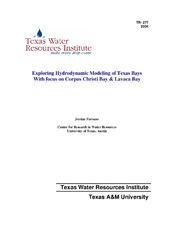| dc.description.abstract | The work presented in this report is the basis for a portion of the author’s dissertation
research. On a grand scheme, this research will enhance the effectiveness of hydrodynamic
modeling and data development for Texas waterbodies, as well as for TMDL modeling in
the United States. As of yet, this work is unfunded, which allows the author great
flexibility in his choice of subject, project, and timeframe. However, the search for funding
is far reaching and constant. The results presented in this report will likely serve as the
basis for future funding proposals.
The purpose of this project was ultimately to develop a hydrodynamic model of Corpus
Christi Bay along the Gulf Coast of Texas. Field data has shown that seasonal hypoxia
occurs near the benthic environment within the southern section of the bay near the
interface with Laguna Madre. Previous modeling studies have not identified the causes of
this hypoxia. However, the previous modeling attempts were 2D in nature and used
simplified inputs and boundary conditions. A sophisticated 3D model incorporating a wide
range of environmental variables will likely reveal those factors leading to the hypoxia.
In order to develop such a model, much environmental and spatial data needed to be
collected. This data includes information on regional wind patterns, tidal data, river inflow
data, and weather data. It also was necessary to develop a methodology for bathymetry
data generation using the ArcView/ArcGIS software, to develop a methodology for
adjusting the bathymetry to include changes, and to develop a methodology for linking the
generated bathymetry into the ELCOM hydrodynamic model. It was also necessary to
develop a methodology for displaying and processing the ELCOM model results in the
ArcView/ArcGIS system. Such a representation will be useful in disseminating the model
results in a form that will allow a greater number of users to view, manipulate, and make
decisions based on this data.
Finally, the robustness of the ELCOM model needed to be ascertained. Hydrodynamic
models should produce accurate results with any set of spatially consistent input data. To
test the robustness of the ELCOM model, model runs were to be developed with spatial
input data identical in every way, except for the data orientation with respect to the model
grid. A methodology for creating, comparing, and displaying results in various spatial
orientations needed to be developed and tested. For this purpose, Lavaca Bay was used as
the study area. Lavaca Bay contains two approximately linear features in its bathymetry
that would suggest the data orientation might affect the model results.
The author hoped that working on this project would provide him with insight into all
aspects of the hydrodynamic modeling process. Although modeling results were not
obtained, the basis for future modeling efforts was firmly developed. This project also
generated ideas for other avenues of research which might be included in the author’s
dissertation. These ideas are presented in the final section of this report. | en |


